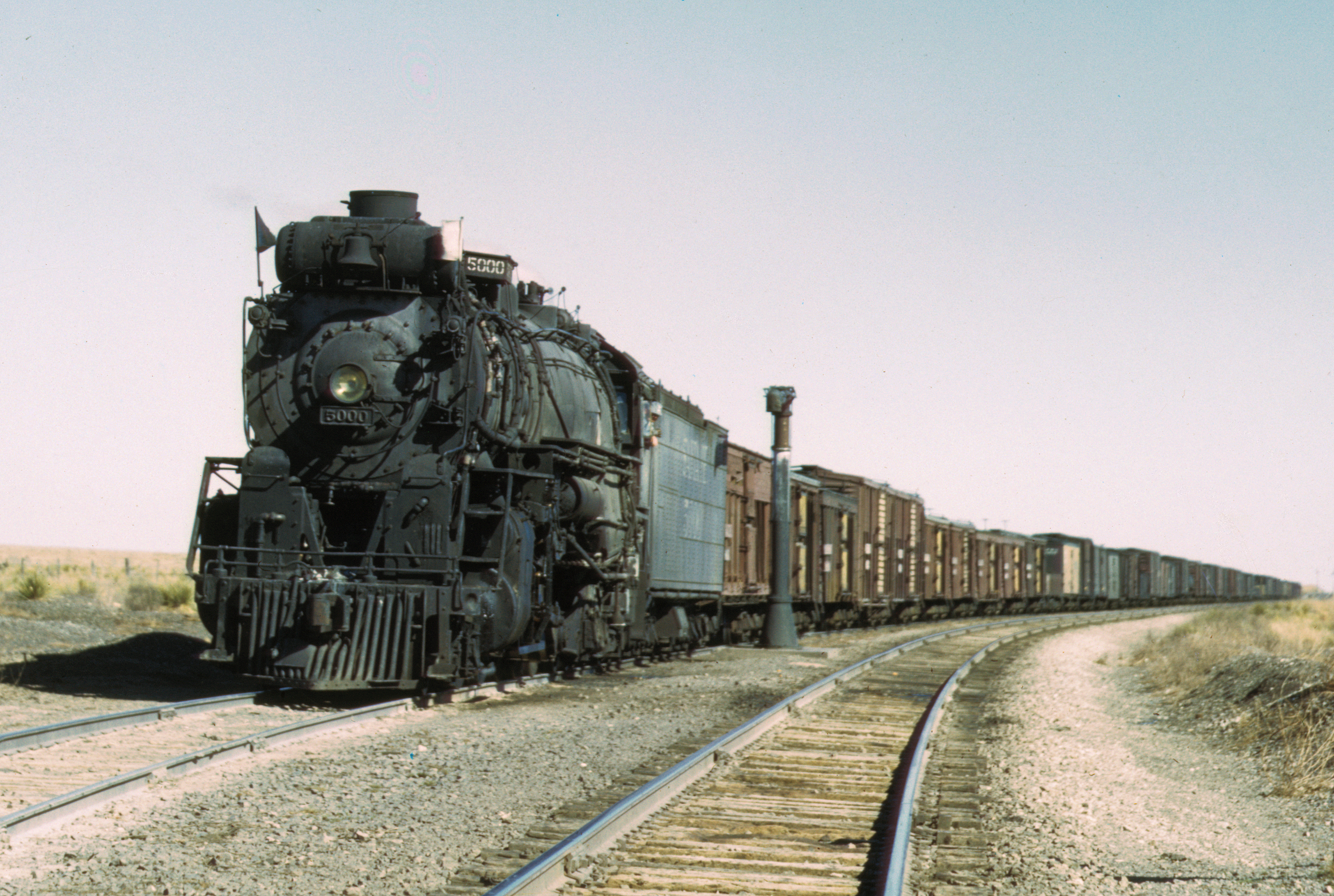- Santa Fe 5000
Infobox Locomotive
name="Santa Fe 5000"
caption=Atchison, Topeka & Santa Fe Railway 2-10-4 steam locomotive #5000 "Madame Queen" waiting in a siding to meet an eastbound train. Ricardo, New Mexico, March 1943.

powertype=Steam
gauge=RailGauge|ussg
builder=Baldwin Locomotive Works
builddate=1930
railroad=Atchison, Topeka and Santa Fe Railway
whytetype=2-10-4
boiler=convert|108|in|abbr=on diameter
firegrate=convert|121.7|sqft|abbr=on
cylindersize=convert|30|in|abbr=on diameter x convert|34|in|abbr=on stroke
driversize=convert|69|in|abbr=on diameter
wheelbase=convert|24|ft|6|in|abbr=on (driving wheelbase)
deliverydate=
currentowner=city ofAmarillo, Texas
retiredate=April 17 ,1957
restoredate=
disposition=Static display inAmarillo, Texas
roadnumber=5000
officialname=
firearea=The Santa Fe 5000 is a2-10-4 steam locomotive constructed byBaldwin Locomotive Works in 1930 for the North AmericanAtchison, Topeka and Santa Fe Railway . Locomotive number 5000 was immediatelynickname d "Madame Queen." Worley, E. D.: "Iron Horses of the Santa Fe Trail.", page 333. Southwest Railroad Historical Society, 1965] and remained a one of a kind member of its own class. The 5000 was donated to the city ofAmarillo , Texas in 1957 and is currently maintained by the Railroad Artifact Preservation Society. The Santa Fe 5000 is on theNational Register of Historic Places .Construction
The Texas type on the Santa Fe is by design a Berkshire with an additional driving axle, as it was ordered by most railroads. Although Santa Fe 3829 was the first steam locomotive with the 2-10-4 wheel arrangement, Santa Fe 5000 served as the
prototype for all further 2-10-4 locomotives rostered by the road.In 1930, the Santa Fe looked at the contemporary heavy-duty motive power policies of other railroads, and decided that its own needed substantial reappraisal. Additional locomotives were ordered as a result of this study, including the 5000. Santa Fe 5000 was placed in service between Clovis and
Vaughn, New Mexico for observation. The result was the company had purchased a locomotive which would pull 15% more tonnage in 9% less time, burning 17% less coal per 1000 gross ton miles than its 3800 series 2-10-2s.Fact|date=November 2007Although the 5000 was a success, the 1930s brought the national depression and the Santa Fe adopted a policy of avoiding capital expendetures during this peiod. By the time the next 2-10-4s were delivered in 1938 they were placed in a different class because of many design refinements. With the various classes of
4-8-4 types, the 2-10-4 type represented the pinnacle of modern heavy power development on the Santa Fe Railway System. [Worley, E. D.: "Iron Horses of the Santa Fe Trail.", page 353. Southwest Railroad Historical Society, 1965]Modifications
The Santa Fe 5000 underwent few modifications during its service life. It received a larger 'square tender' which required the cab roof to be modified with an area that allowed crew members to pass from the cab to the top of the tender. In 1940 the locomotive was converted from
coal to oilfuel .Preservation
On
April 17 ,1957 , after several years of storage and convert|1750000|mi of service, Santa Fe 5000 was retired and donated to the city ofAmarillo, Texas . The Santa Fe 5000 was placed on outdoor static display at the Santa Fe station. In August 2005, the 5000 was moved by the Railroad Artifact Preservation Society to a new location in Amarillo where they plan to construct a building to house and preserve the locomotive.References
External links
* [http://trees.ancestry.com/objects/download/ebcc811b-3ea5-45a0-bcdb-43743a442979/The%20Madame%20Queen.pdf 1979 Article on the Madame Queen]
* [http://trees.ancestry.com/objects/download/18ecb9a2-282f-41a8-9d57-6c5ea1e3ab55/AT_amp;SF%20Historic%20Writing%20Pro.pdf 1981 Article on putting the Madame Queen on the Nat. Register of Historic Places]
* [http://www.railroadartifactpreservation.org Railroad Artifact Preservation Society of Amarillo, TX]
Wikimedia Foundation. 2010.
